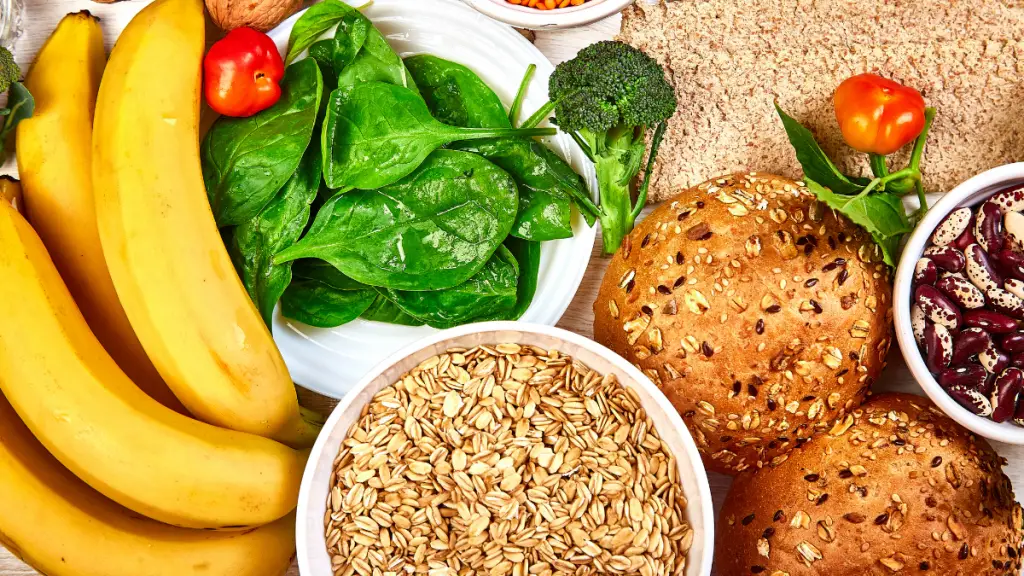
Gaining excess belly fat, especially visceral fat, can pose serious health risks and increase the likelihood of chronic conditions like type 2 diabetes and heart disease. If you’re looking to slim down your midsection and improve your overall health, there are effective strategies for belly fat reduction that you can implement.
To start shedding belly fat efficiently, it’s important to make a few key lifestyle changes. These quick methods to reduce belly fat can help you achieve your goals and maintain a healthier body.
First and foremost, focus on your diet. Incorporating foods rich in soluble fiber can aid in belly fat loss. Soluble fiber can be found in fruits, vegetables, legumes, oats, and barley. It helps increase fullness and reduce calorie absorption, making it an excellent addition to your weight loss journey.
Avoiding trans fats is another essential step in losing abdominal fat quickly. Trans fats, commonly found in margarines, spreads, and packaged foods, have been linked to inflammation, heart disease, insulin resistance, and abdominal fat gain. By limiting your intake of trans fats, you can support your belly fat reduction efforts.
Alcohol intake can also impact your waist size and contribute to belly fat gain. Studies have shown a significant association between heavy alcohol consumption and excess fat storage around the waist. Consider moderating your alcohol intake or abstaining completely to promote belly fat loss.
A high-protein diet can play a crucial role in reducing belly fat. Including protein-rich foods like meat, fish, eggs, dairy, and beans in your meals can increase the release of the fullness hormone, decrease appetite, and help retain muscle mass during weight loss.
Stress management is equally important when it comes to slimming down your midsection. High-stress levels trigger the release of cortisol, a stress hormone that leads to increased appetite and fat storage around the waist. Engaging in stress-reducing activities like yoga or meditation can aid in reducing belly fat.
Key Takeaways:
- Eating a diet rich in soluble fiber can aid in belly fat loss.
- Avoid trans fats to reduce abdominal fat gain.
- Moderate alcohol intake or abstain completely to support belly fat reduction.
- Including protein-rich foods in your diet can aid in weight management and reduce abdominal fat.
- Managing stress levels through activities like yoga or meditation can help reduce belly fat.
The Role of Soluble Fiber in Belly Fat Loss

When it comes to losing belly fat and achieving a leaner waistline, including soluble fiber in your diet can be a game-changer. Soluble fiber, which is found in a variety of plant-based foods, offers numerous benefits for weight loss and reducing belly fat.
Soluble fiber is commonly found in fruits, vegetables, legumes, oats, and barley. It dissolves in water and forms a gel-like substance in the digestive system, which helps promote feelings of fullness and satiety. By increasing your intake of soluble fiber, you can curb your appetite and reduce the likelihood of overeating.
Additionally, soluble fiber plays a crucial role in reducing calorie absorption. As the gel-like substance formed by soluble fiber moves through the digestive system, it slows down the digestion and absorption of nutrients, including calories. This can lead to a decreased calorie intake and contribute to weight loss.
Moreover, research has shown that consuming high-fiber foods, particularly those rich in soluble fiber, can help in reducing belly fat over time. Belly fat, also known as visceral fat, is the fat that accumulates around the abdominal area and is associated with an increased risk of various health conditions.
“Including high fiber foods in your diet can be a simple yet effective strategy for shedding belly fat and improving your overall health.”
To incorporate more soluble fiber into your daily meals, consider adding a variety of high fiber foods to your diet. Fruits like apples, berries, and oranges, vegetables such as broccoli, carrots, and sweet potatoes, and legumes like lentils and black beans are excellent sources of soluble fiber.
Additionally, whole grains like oats and barley can provide a significant amount of soluble fiber and make for a healthy and filling breakfast or snack option.
By including these high fiber foods in your meals and snacks, you can increase your soluble fiber intake and support your weight loss and belly fat reduction goals.
Incorporating soluble fiber into your diet is a simple yet effective way to promote weight loss and reduce belly fat. By choosing whole, natural foods rich in soluble fiber, you can support your journey towards a slimmer waistline and improved overall health.
The Impact of Trans Fats on Belly Fat
When it comes to belly fat, one of the culprits that can contribute to its gain is trans fats. These unhealthy fats are commonly found in some margarines, spreads, and packaged foods. Consuming trans fats has been linked to various health issues, including inflammation, heart disease, insulin resistance, and yes, you guessed it, abdominal fat gain.
Research suggests that trans fats not only increase the storage of fat around the waistline but also promote inflammation in the body. This can further disrupt metabolic processes and lead to insulin resistance, a condition associated with weight gain and difficulty in losing belly fat.
By limiting the intake of trans fats, you can help reduce abdominal fat. Instead, opt for healthier fats like monounsaturated and polyunsaturated fats found in olive oil, avocados, and nuts. These fats can provide essential nutrients and support overall health without the negative impact on belly fat.
Remember, it’s all about making conscious choices when it comes to what we put into our bodies. By avoiding trans fats and opting for healthier alternatives, you can take an active step towards reducing belly fat and improving your overall well-being.
| Trans Fats | Impact on Belly Fat |
|---|---|
| Promote inflammation | Increase abdominal fat gain |
| Linked to heart disease | Associated with insulin resistance |
| Commonly found in margarines, spreads, and packaged foods | Can disrupt metabolic processes |
By being mindful of your trans fat intake and making healthier choices, you can take control of your belly fat and pave the way for a healthier future.
Alcohol and Belly Fat
Excessive alcohol intake can have negative effects on your waistline and contribute to the accumulation of belly fat. Observational studies have shown a significant link between heavy alcohol consumption and the storage of excess fat around the waist.
When alcohol is consumed, it is prioritized by the body for metabolization, which can result in the temporary suspension of fat burning. Additionally, alcohol can increase appetite and lead to consuming more calories than needed, further promoting weight gain and belly fat formation.
In order to reduce belly fat and maintain a healthy weight, it is advisable to moderate alcohol consumption or abstain completely. By limiting your intake, you can decrease the number of empty calories and reduce the risk of excess fat storage around your waist.
To support your efforts in shedding belly fat, consider implementing the following strategies:
- Moderate alcohol intake: Aim for no more than one drink per day for women and two drinks per day for men. This guideline is in line with recommendations from the Dietary Guidelines for Americans.
- Choose healthier drink options: Opt for lower-calorie alcoholic beverages such as light beer, dry wines, or spirits mixed with soda water or low-calorie mixers.
- Stay hydrated: Drink plenty of water alongside alcohol consumption to stay hydrated and help reduce the overall caloric intake.
- Practice mindful drinking: Be aware of portion sizes and pace your consumption, allowing time for your body to metabolize the alcohol.
Above all, it’s important to remember that a balanced approach to alcohol consumption is key. If you have concerns about your alcohol intake or its impact on your health and efforts to reduce belly fat, consult with a healthcare professional or registered dietitian for personalized guidance.
“Moderating alcohol intake is a valuable step toward reducing belly fat and promoting overall health.”
– Dr. Sarah Thompson, Registered Dietitian
By making mindful choices and incorporating healthy habits into your lifestyle, you can effectively support your journey to a slimmer waistline and a healthier you.
The Importance of a High Protein Diet
When it comes to weight management and reducing abdominal fat, a high protein diet plays a crucial role. Not only does protein increase the release of the fullness hormone, making you feel satisfied and less likely to overeat, but it also helps decrease appetite and retain muscle mass during weight loss.
Including protein-rich foods in your diet can support your journey in shedding belly fat. Incorporating sources like meat, fish, eggs, dairy, and beans can provide you with the necessary protein to reach your goals. Here are some examples of protein-rich foods:
| Food | Protein Content (per 100g) |
|---|---|
| Chicken breast | 31g |
| Salmon | 20g |
| Eggs | 13g |
| Greek yogurt | 10g |
| Black beans | 21g |
Having a high-protein diet not only helps you feel full and satisfied, but it also has a higher thermic effect compared to carbohydrates and fats. This means that your body burns more calories during digestion, resulting in increased metabolism and potential fat loss.
Additionally, consuming a high-protein diet can support muscle growth, which is essential for a toned and defined physique. Retaining muscle mass is especially important during weight loss as it helps prevent metabolic slowdown and improves overall body composition.
Remember, a high-protein diet should be accompanied by other healthy lifestyle habits such as regular exercise and balanced nutrition. By incorporating protein-rich foods into your meals and snacks, you can optimize your weight management efforts and reduce abdominal fat effectively.
Managing Stress for Belly Fat Loss
Stress can have a significant impact on our bodies, including the accumulation of fat around the waist. When we’re stressed, our bodies release cortisol, which is a stress hormone that can lead to increased appetite and fat storage around the midsection.
To combat the effects of stress on belly fat, it’s important to incorporate stress reduction techniques into our daily routines. One effective method is engaging in activities like yoga or meditation, which can help relax the mind and body.
Yoga, in particular, has been shown to reduce cortisol levels, lower stress, and promote overall well-being. By practicing yoga regularly, you can not only manage stress but also support your journey towards belly fat loss.
Another stress reduction technique is meditation. Taking a few minutes each day to focus on your breath and clear your mind can have profound effects on stress levels. Research has shown that regular meditation can decrease cortisol levels, making it an excellent tool for reducing belly fat.
Stress Reduction Techniques:
- Yoga:
- Practice yoga poses that promote relaxation, such as child’s pose, corpse pose, and seated forward fold.
- Join a yoga class or follow online tutorials to learn proper techniques.
- Meditation:
- Find a quiet space where you can sit comfortably.
- Focus on your breath and let go of any intrusive thoughts.
- Start with short meditation sessions and gradually increase the duration.
- Deep Breathing:
- Breathe in deeply through your nose, filling your lungs with air.
- Exhale slowly through your mouth, releasing any tension or stress.
- Repeat this deep breathing exercise several times whenever you feel stressed.
“Stress reduction techniques like yoga and meditation can not only improve your mental well-being but also help in reducing belly fat by reducing cortisol levels.” – Dr. Emily Johnson, Yoga & Meditation Expert
By incorporating stress reduction techniques into your daily routine, you can effectively manage stress levels and support belly fat loss. Remember, a healthy body starts with a calm mind.
Minimizing Sugar Intake for Belly Fat Reduction

Excess sugar intake, including natural sugars, is associated with weight gain and increased abdominal fat. Consuming high amounts of added sugar can lead to chronic diseases such as heart disease, type 2 diabetes, and fatty liver disease. To support belly fat reduction, it is crucial to limit the intake of sugary foods and beverages.
When it comes to sugar, moderation is key. While small amounts of sugar are naturally found in fruits and dairy products, it is the added sugars in processed and packaged foods that contribute to excessive intake. These added sugars can often go unnoticed, as they can be present in surprising amounts in products like sodas, sweets, sauces, and cereals.
Reading food labels and being aware of the different names for added sugars can help in identifying and limiting sugar consumption. Some common names for added sugars include cane sugar, corn syrup, high-fructose corn syrup, maltose, and sucrose.
The Hidden Dangers of Excess Sugar
Excessive sugar intake can lead to a range of health issues, including:
- Weight gain: Consuming too much sugar leads to an excess intake of calories, which can contribute to weight gain and the accumulation of belly fat.
- Increased risk of chronic diseases: A high-sugar diet has been linked to an increased risk of chronic conditions such as heart disease, type 2 diabetes, and fatty liver disease. These conditions can further contribute to abdominal fat gain.
- Inflammation: Excess sugar consumption can trigger inflammation in the body, which may promote the storage of abdominal fat.
- Insulin resistance: Regularly consuming sugary foods and beverages can lead to insulin resistance, a condition in which the body becomes less responsive to the effects of insulin. Insulin resistance has been associated with weight gain, particularly in the abdominal area.
By reducing sugar intake, you can not only support belly fat reduction but also improve your overall health. Instead of reaching for sugary snacks and drinks, opt for healthier alternatives like fruits, unsweetened beverages, and natural sweeteners like stevia or monk fruit extract.
“Limiting sugar consumption is key to achieving a healthy weight and reducing the risk of chronic diseases associated with excess sugar intake.”
Remember, making small changes to your diet can have a significant impact on your belly fat loss journey. Start by gradually reducing sugar intake and exploring new ways to satisfy your sweet tooth without sacrificing your health goals.
Healthy Sugar Substitutes
When it comes to reducing sugar intake, it can be helpful to explore healthier alternatives. Here are some natural sweeteners that you can incorporate into your diet:
| Sugar Substitute | Taste | Suitable for Cooking/Baking? |
|---|---|---|
| Stevia | Sweet, similar to sugar | Yes |
| Monk Fruit Extract | Sweet, similar to sugar | Yes |
| Erythritol | Mildly sweet, similar to sugar | Yes |
| Xylitol | Mildly sweet, similar to sugar | Yes |
| Honey | Sweet, distinct flavor | Yes |
| Maple Syrup | Sweet, rich flavor | Yes |
| Coconut Sugar | Sweet, caramel-like flavor | Yes |
These natural sweeteners can be used as alternatives to refined sugar in cooking and baking. However, it’s important to note that even though they are healthier options, they should still be consumed in moderation.
Reducing sugar intake is a crucial step in achieving belly fat reduction and improving overall health. By being mindful of hidden sources of sugar, reading food labels, and incorporating healthier sweeteners, you can make progress toward your goals. Remember, a balanced and sustainable approach is key to long-term success.
The Role of Aerobic Exercise in Belly Fat Loss
Aerobic exercise, such as cardio workouts, plays a crucial role in reducing belly fat and achieving overall weight loss. Not only does it burn calories, but it also targets the stubborn fat stored around the midsection. Incorporating aerobic exercises into your fitness routine can be a game-changer when it comes to belly fat reduction.
One highly effective aerobic exercise method is high-intensity interval training (HIIT). This form of exercise alternates between intense bursts of activity and short periods of rest or low-intensity exercise. HIIT has been shown to be particularly beneficial in burning calories and targeting belly fat.
Studies have found that HIIT can significantly reduce visceral fat, the type of fat that surrounds organs in the abdominal cavity, leading to improved overall health. It also helps improve cardiovascular fitness, making it an excellent choice for burning calories and shedding belly fat.
Incorporating different types of aerobic exercises, such as running, cycling, swimming, or dancing, can help keep your fitness routine varied and enjoyable. Aim for at least 150 minutes of moderate-intensity aerobic exercise or 75 minutes of vigorous-intensity aerobic exercise per week, as recommended by the American Heart Association.
Benefits of Aerobic Exercise for Belly Fat Loss:
- Burns calories and promotes weight loss
- Targets belly fat and reduces waist circumference
- Improves cardiovascular fitness
- Reduces the risk of chronic diseases
- Boosts metabolism and increases calorie-burning
“Aerobic exercise is an effective way to burn calories and reduce belly fat. Incorporating high-intensity interval training can further enhance the results. Stay consistent and make aerobic exercise a regular part of your fitness routine for optimal belly fat reduction.” – Fitness Expert
Remember to consult with a healthcare professional or fitness expert before starting a new exercise program, especially if you have any underlying medical conditions.
| Aerobic Exercises | Calories Burned in 30 Minutes* |
|---|---|
| Running (8 mph) | 400-500 |
| Cycling (moderate intensity) | 250-400 |
| Swimming (vigorous effort) | 350-450 |
| Dancing (high impact) | 300-400 |
*Calories burned may vary based on individual factors such as weight, intensity, and fitness level.
The Impact of Carbohydrate Intake on Belly Fat

Reducing carbohydrate intake is a key strategy for reducing belly fat and promoting weight loss. Low-carb diets have been shown to be effective in targeting abdominal fat and improving metabolic health.
By limiting carb intake, especially refined carbs, you can help your body shift from using glucose as its primary fuel source to burning stored fat for energy. This process, known as ketosis, can lead to significant reductions in belly fat.
The Science Behind Low Carb Diets
Low carb diets restrict the consumption of high-carbohydrate foods like bread, pasta, rice, and sugary snacks. Instead, they promote the consumption of healthy carb sources such as whole grains, legumes, and vegetables.
When you reduce carb intake, your body’s insulin levels decrease, which helps release stored fat from fat cells. Additionally, low-carb diets can help control appetite and reduce calorie intake, leading to weight loss and belly fat reduction.
According to a study published in the American Journal of Clinical Nutrition, participants who followed a low-carb diet experienced greater reductions in abdominal fat compared to those on a low-fat diet.
Choosing Healthy Carb Sources
While low-carb diets limit overall carb intake, it’s important to choose healthy carb sources to ensure you still receive essential nutrients. Here are some examples of healthy carb sources:
| Healthy Carb Sources | Examples |
|---|---|
| Whole Grains | Brown rice, quinoa, whole wheat bread |
| Legumes | Black beans, lentils, chickpeas |
| Vegetables | Broccoli, spinach, kale |
These carb sources provide essential nutrients like fiber, vitamins, and minerals while keeping blood sugar levels more stable compared to refined carbs.
Incorporating low-carb, healthy-carb sources into your diet can help you achieve belly fat reduction and promote overall health.
“Reducing carb intake, particularly refined carbs, can help in losing belly fat. Low carb diets have been associated with belly fat loss, improved metabolic health, and weight loss.”
Resistance Training for Belly Fat Reduction
Resistance training, also known as weightlifting or strength training, is an essential component of any fitness routine aimed at reducing belly fat and achieving a leaner physique. While cardiovascular exercises like running and cycling are effective for burning calories, resistance training offers unique benefits in building and maintaining muscle mass, increasing metabolism, and facilitating long-term fat loss.
During resistance training, the muscles are subjected to external resistance, typically through the use of free weights, weight machines, or bodyweight exercises. This form of exercise stimulates muscle fibers, leading to the growth and strengthening of muscles. As the muscles adapt and become stronger, they require more energy, thus increasing calorie expenditure even at rest.
Building Muscle Mass: One of the main advantages of resistance training is its ability to build lean muscle mass. By engaging in regular strength training exercises, you can increase your muscle mass, which contributes to a higher resting metabolic rate. This means that even when you’re not exercising, your body will burn more calories to maintain your muscle tissue, aiding in overall fat loss.
Burning Calories: Resistance training helps burn calories during and after your workout. While aerobic exercises predominantly burn calories while performing the activity, strength training continues to burn calories for hours or even days after your workout. This is known as the “afterburn effect” or excess post-exercise oxygen consumption (EPOC), where your body works to restore itself to pre-exercise levels, requiring additional energy and thereby burning more calories.
Combining resistance training with aerobic exercises can yield even greater results in belly fat reduction. Aerobic exercises provide cardiovascular benefits and aid in burning calories, while resistance training builds muscle mass and increases metabolism. This synergistic approach can create a more effective fat-burning environment and help you achieve your fitness goals faster.
Remember that proper form and technique are crucial in resistance training to prevent injury and maximize results. It is recommended to start with lighter weights or resistance bands and gradually increase as your strength and proficiency improve. Additionally, incorporating a variety of exercises that target different muscle groups provides a well-rounded approach to resistance training.
Make resistance training a regular part of your fitness routine, aiming for at least two to three sessions per week. Focus on compound exercises that involve multiple muscle groups, such as squats, deadlifts, push-ups, and pull-ups. Gradually increase the intensity and challenge yourself to continue progressing and stimulating muscle growth.
Committing to resistance training not only aids in belly fat reduction but also enhances overall strength, endurance, and muscle tone. Prioritize consistent training, balanced nutrition, and ample rest to optimize your results and promote sustainable, long-term changes to your body composition.
| Benefits of Resistance Training for Belly Fat Reduction | Examples of Resistance Training Exercises |
|---|---|
|
|
Conclusion
Losing belly fat is not just about achieving a slimmer waistline but also improving your overall health. With a commitment to healthy lifestyle changes, you can effectively shed belly fat and enjoy a better quality of life.
One of the key strategies for belly fat loss is incorporating more soluble fiber into your diet. Foods like fruits, vegetables, legumes, oats, and barley are rich in soluble fiber and can help increase fullness and reduce calorie absorption, supporting your weight loss journey.
Avoiding trans fats, moderating alcohol consumption, and consuming a high-protein diet are also important steps in your belly fat loss journey. Trans fats found in certain margarines, spreads, and packaged foods can lead to inflammation and abdominal fat gain, while excessive alcohol intake has been linked to increased belly fat. A high-protein diet, on the other hand, can aid in weight management and reducing abdominal fat.
Additionally, managing stress levels, cutting back on sugary foods, doing aerobic exercises, limiting carb intake, and incorporating resistance training can further contribute to belly fat reduction. By making these healthy lifestyle changes and focusing on sustainable practices rather than quick fixes, you can achieve your belly fat loss goals and improve your overall well-being.
FAQ
What are some quick tips for shedding belly fat fast?
Some quick tips for shedding belly fat fast include eating more soluble fiber, avoiding trans fats, moderating alcohol intake, consuming a high protein diet, reducing stress levels, eating fewer sugary foods, doing aerobic exercises, cutting back on carbs, incorporating resistance training, and making healthy food choices.
How does soluble fiber help in belly fat loss?
Soluble fiber, found in fruits, vegetables, legumes, oats, and barley, helps in losing weight by increasing fullness and reducing calorie absorption. It has also been associated with a reduction in belly fat gain over time.
What is the impact of trans fats on belly fat?
Consuming trans fats, which are found in some margarines, spreads, and packaged foods, has been linked to inflammation, heart disease, insulin resistance, and abdominal fat gain. Limiting the intake of trans fats can be helpful in reducing belly fat.
How does alcohol affect belly fat?
Excessive alcohol intake has been associated with increased belly fat. Observational studies have shown a significant link between heavy alcohol consumption and excess fat storage around the waist. Moderating alcohol intake or abstaining completely can be beneficial for reducing belly fat.
Why is a high-protein diet important for belly fat reduction?
Consuming a high-protein diet can aid in weight management and reducing abdominal fat. Protein increases the release of the fullness hormone, decreases appetite, and helps retain muscle mass during weight loss. Including protein-rich foods like meat, fish, eggs, dairy, and beans in your diet can support belly fat reduction.
How does stress impact belly fat?
Stress can contribute to belly fat gain by triggering the release of cortisol, the stress hormone. Increased cortisol levels lead to appetite stimulation and fat storage around the middle. Engaging in stress-reducing activities like yoga or meditation can be beneficial for reducing belly fat.
Why is minimizing sugar intake important for belly fat reduction?
Excess sugar intake, including natural sugars, is associated with weight gain and increased abdominal fat. Consuming high amounts of added sugar can lead to heart disease, type 2 diabetes, and fatty liver disease. Limiting the intake of sugary foods and beverages can support belly fat reduction.
How does aerobic exercise help in reducing belly fat?
Aerobic exercise, such as cardio workouts, is an effective method for burning calories and reducing overall body fat, including belly fat. High-intensity interval training (HIIT) can be particularly beneficial. Incorporating aerobic exercises into your fitness routine can support belly fat loss.
What is the impact of carbohydrate intake on belly fat?
Reducing carbohydrate intake, particularly refined carbs, can help in losing belly fat. Low carb diets have been associated with belly fat loss, improved metabolic health, and weight loss. Choosing healthy carb sources like whole grains, legumes, and vegetables can aid in belly fat reduction.
How does resistance training contribute to belly fat reduction?
Resistance training, also known as weightlifting or strength training, is important for building and maintaining muscle mass. It helps in burning calories throughout the day, even at rest. Combining resistance training with aerobic exercise can be effective for belly fat reduction.
How can I lose belly fat through healthy lifestyle changes?
Losing belly fat requires a combination of healthy lifestyle changes, including dietary adjustments and regular exercise. By incorporating strategies like increasing soluble fiber intake, avoiding trans fats, moderating alcohol consumption, consuming a high protein diet, managing stress levels, cutting back on sugary foods, doing aerobic exercises, limiting carb intake, incorporating resistance training, and making healthy food choices, you can effectively shed belly fat and improve your overall health. Remember to focus on long-term sustainable changes rather than quick fixes.
Hey there, I’m Luke, and I’ve been immersed in the fitness world since 2007. From gym floors to running my own personal training business, I’ve seen it all. My journey led me to study Sports Science at university, where I deepened my understanding of the science behind exercise.
One thing that truly lights my fire? High-Intensity Interval Training (HIIT). It’s not just a workout; it’s a game-changer. I’ve used HIIT to help countless men and women shed weight and transform their lives for the better.
Through my personal training business, I’ve witnessed the incredible impact of HIIT on both physical and mental well-being. It’s not just about getting fitter; it’s about feeling stronger, more confident, and more resilient.
Join me on this journey to a healthier, happier you. Let’s crush those goals together!

